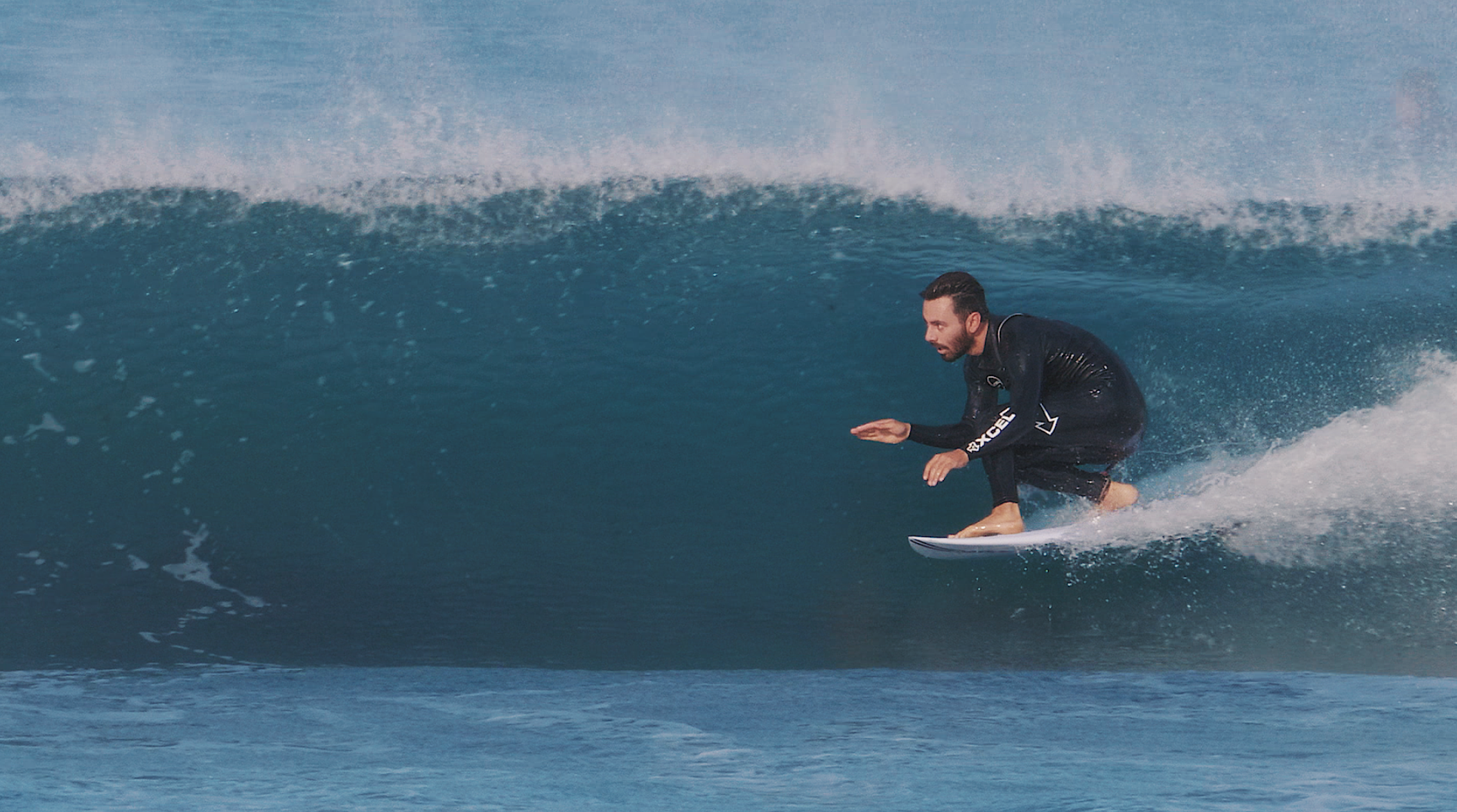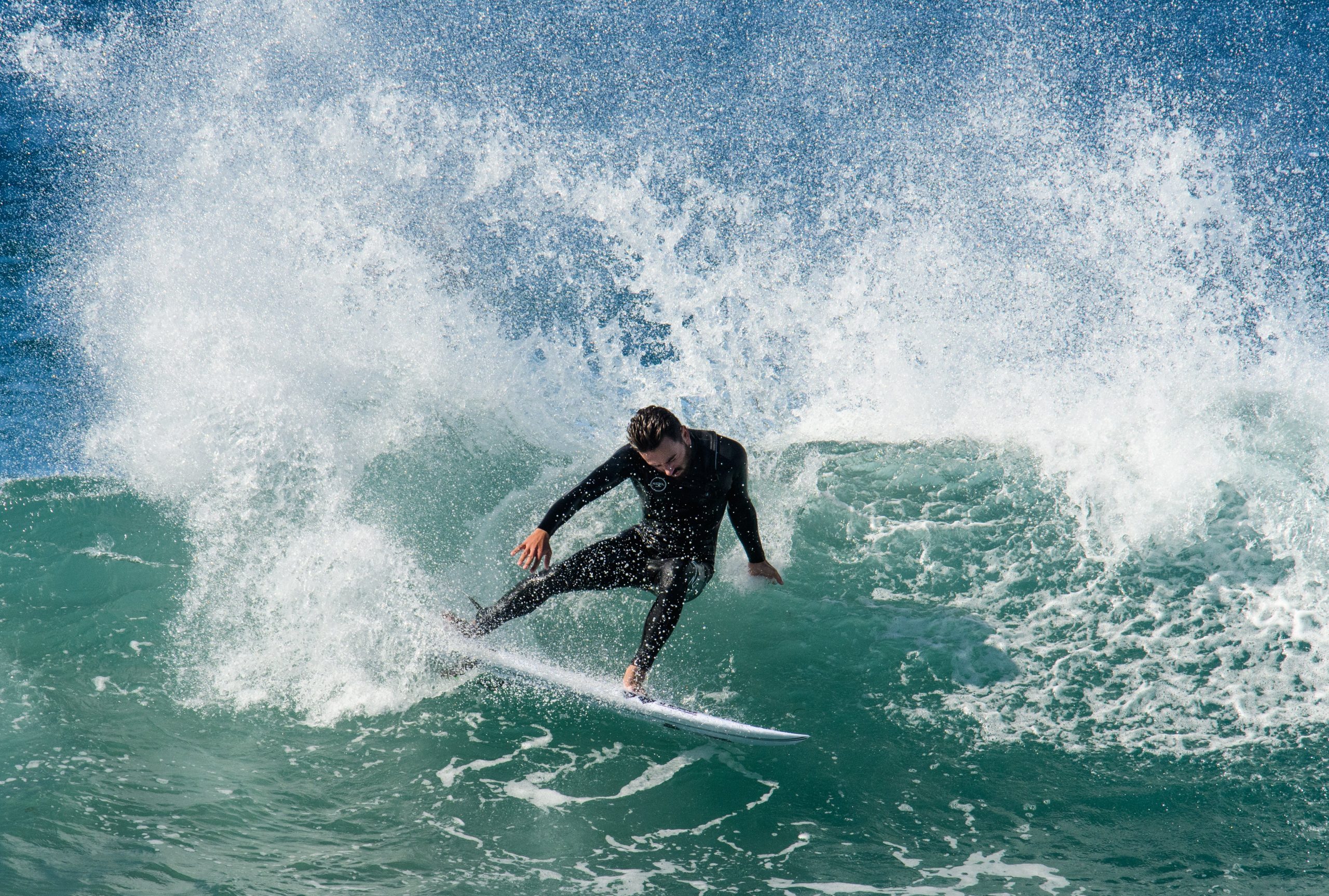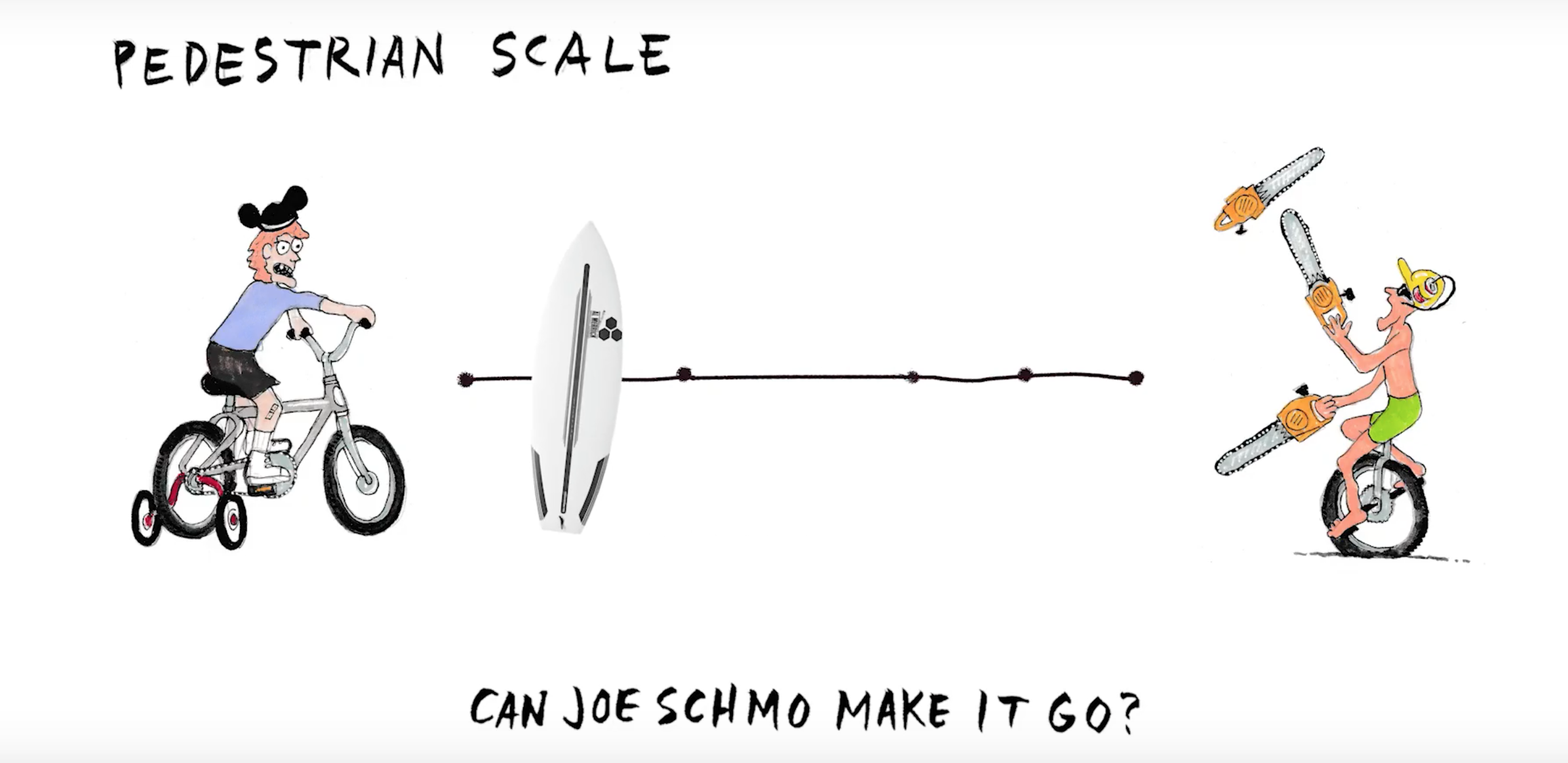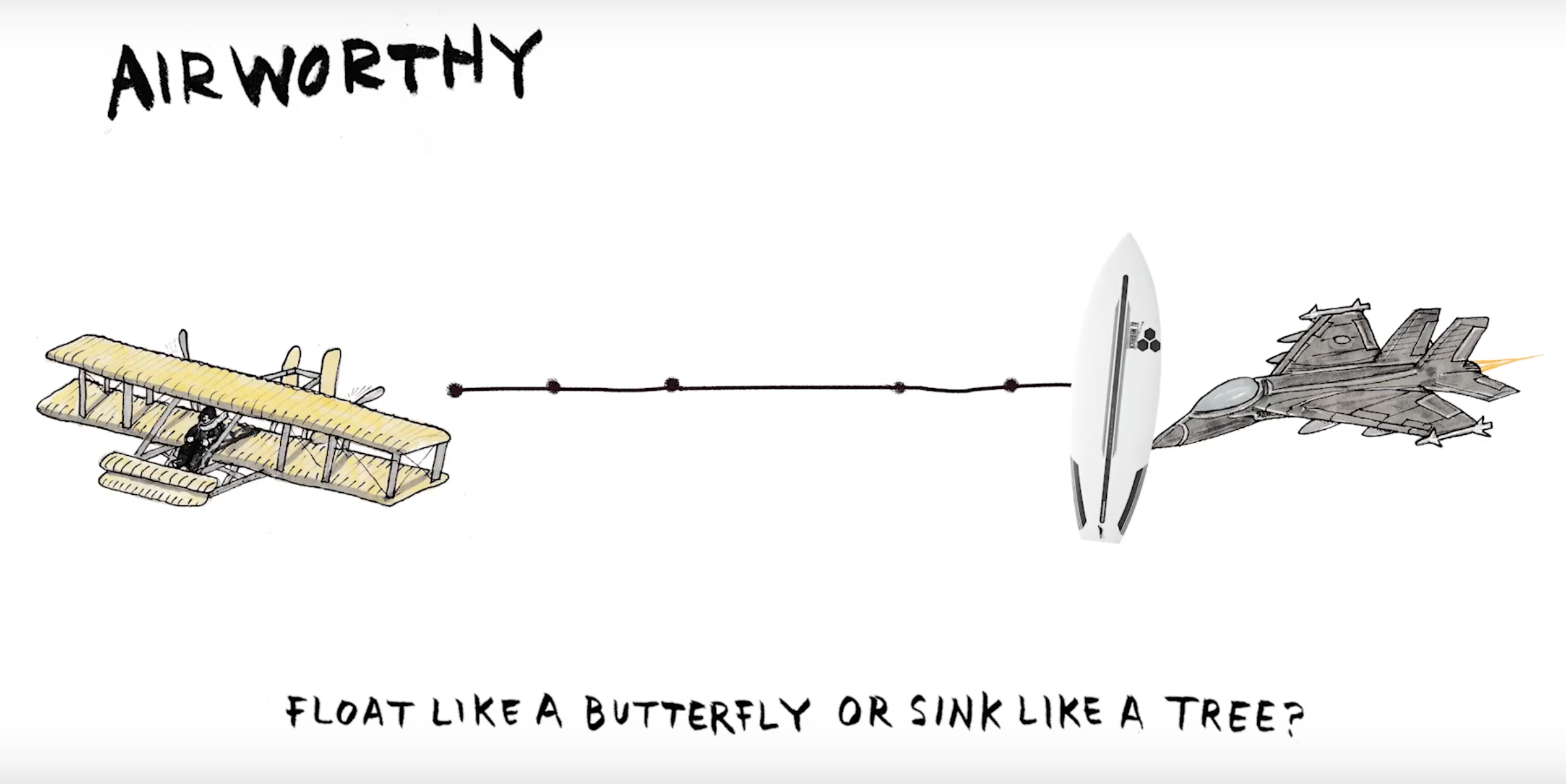An Honest Review Of The Channel Islands Neck Beard 2
Testing the Dane Reynolds remake that your lineup can’t stop talking about.
Dane Reynolds thrashed it in Electric Acid; Eithan Osborne elevated it in Stab High; Patty Gudang gave it a good spin (or three) at Lowers.
These performances made it all but impossible to ignore Channel Islands’ new chop-tail, step-down craft — the Neck Beard 2.
So we decided to test it for ourselves.

Available in all sorts of sizes and constructions!
Photography
Ben Judkins
But first, some history
“Back in 2009, Dane was in a place where he wanted to feel something different – something that had a little more flow,” said Dane’s lifelong design partner and heir to the Channel Islands throne, Britt Merrick. “He’d always been so focused on the most high performance equipment, I think Dane just wanted a board that was just more fun. Along with the Dumpster Diver, the Neck Beard was one of his first real ‘step-down’ boards, which are extremely common now but they weren’t back then.”
In 2019, it’s rare to see non-professionals on a “standard shortboard” — a thin, narrow, curvy slice of foam ridden at or above the surfer’s height. But back in 2009, shorter, wider crafts were considered to be for hippies and punks, not the everyday shredder.
Reynolds wanted to change that.
“Dane was getting frustrated with some of the boards he was trying, so he told one of our shapers to take an MBB3 (a Shane Beschen shortboard model) and chop a foot off the tail, and he’d ride it like that,” Merrick revealed.
Despite the prototype’s crude and aggressive lines, Dane felt something special in the chop-tail craft and worked on dialing it to perfection. After several tweaks in the tail, rocker, and outline, Dane and Britt landed on a version they were happy with, which became the Neck Beard (named after Shane Beschen’s infamously furry headstalk).

Then in 2018, Stab formulated a plan to get Dane Reynolds on 10 “alternative” surfcrafts (from eight-foot gliders to fork-nosed asymmetricals) to see what constituted as great, garish, and gimmicky design theory.
In order to include Channel Islands — a historically performance-minded surfboard brand— in the Electric Acid Surfboard Test, we needed them to provide something funky and unique.
After some contemplation from Britt and co., thee CI team decided to put a modern spin on their original Neck Beard — this one with a severely squared tail, straightened rocker, and made from epoxy.
And the results speak for themselves. After seeing what Dane achieved on the Neck Beard 2 in Electric Acid, followed by noteworthy performances from Eithan Osborne in Waco and Pat Gudauskas at Lowers, we had to try one for ourselves.

The Neck Beard 2, in all its right-angled glory.
Photography
Ben Judkins
The Test
Due to a powerful Santa Ana flow (the same that saw Malibu burn in November of 2018), I first surfed the NB2 in uncommonly offshore San Diego conditions. On what would be considered an average day of swell, the easterly gusts groomed Seaside Reef into an azure playground, with small tubes, wedges, and ramps in abundance.
The Neck Beard 2 screamed with excitement under my feet.
In fact every time I took off, the board wanted one thing and one thing only — to go as fast as possible down the line. At first I fought this sensation, attempting to cut back to the pocket and redirect off the whitewater, but the NB2 downright refused. Wrap-arounds were cinched at the halfway mark, as my fins would begin to slide once the board reached a position parallel to the shore. This frictionless feeling led to some awkward falls and chronic speed-loss, which forced me to reconsider how I was approaching this novel craft.
Halfway through the session, I thought back to something Britt Merrick had said in our earlier interview:
“I think a lot of surfers, especially those who are more skilled, they want to force their approach to surfing on a board. But a lot of boards want to be surfed in different ways — that’s why we’re currently enjoying this “ride anything” culture. You’ve just gotta hop on the Neck Beard 2 and feel what it wants you to feel. Begin to approach your turns and gaining speed in that way.”
After absorbing Britt’s words, I decided to consciously strip back my natural surfing tendencies. Performing little more than direction changes on my next few waves, I was able to feel how the board was moving through the water, sensing its likes and dislikes through my stationary feet. Suddenly it all started to make sense.

If you’re not in the fetal position are you even trying to get tubed?
Photography
Ben Judkins
What I learned:
-
Less is more: After doing next to nothing and still flying down the line, I realized that a little wiggle goes a long way with the NB2. The board’s flat, wide outline offers ample planing area, meaning that waves of all shapes and sizes can become Snapper-like speedruns if negotiated properly.
-
This board ain’t your mama, give it some lip!: The NB2 is quick off the bottom and loves nothing more than to bank, crank, or slide off a feathering lip. After attempting a number of different lines and approaches, I realized that it’s in snappy turns, speed floats, and fin wafts that this board truly excels. If you’ve ever had trouble getting your pegs above the coping, the Neck Beard 2 will show you the way.
-
Don’t look back, Jack: If airs are surfing’s future, then rail turns are its past, and the Neck Beard 2 has no sense of nostalgia. No matter how hard I tried, the NB2 would always choose to slide on the last portion of a cutback or carve. Even watching Dane in the Acid Test (see: 8:17), it’s clear that he struggled to put his full power into the rail without it slipping toward the end. Hence his proclivity for lip-based activities on the NB2 (which is a nod to my above point).

Right about there she’ll start to go limp.
Photography
Nicholas Paoni
Let’s talk about construction
In our last Channel Islands Joyride (on the Rocket Wide, watch here!) I dissected the efficacy of their Spine-Tek epoxy construction, ultimately raising the idea of whether surfers of different sizes should be riding Spines of the different stiffnesses.
The Spine-Tek’s “Spine”, for those uninitiated, is a flexible composite material that’s placed in a cut-out portion of an epoxy blank, right where the stringer would be. They’re designed to strengthen the board and create a more natural spring-like effect under the surfer’s feet.
While I’ve been able to witness this phenomenon through the powerful and dynamic surfing of pros like Dane Gudauskas, I failed to feel it for myself.
This led me to draw a comparison to golfing, wherein players with a slower swing speed use a more flexible shaft to maximize the power and performance of their swing. I then posited that surfers of lesser weight (like myself) might have a better Spine-Tek experience if the stiffness of Spines varied based on the size of their riders.
At this point in time, the only difference between the Spine I was riding and the one Dane G. was riding were their respective lengths, which are chosen in relation to the length of our surf crafts, meaning mine would be shorter than his. Ironically, a shorter Spine of the same width and thickness would theoretically be more stiff than the longer version, as it has less surface area to actually form a curve. (Think about how a full-length pencil can be bent to a certain degree without breaking, whereas a half-length pencil can hardly bend at all.)

Bend baby bend!
Photography
Ben Judkins
While filming for the Neck Beard 2 Joyride, we were able to visit the Channel Islands factory, where their marketing guru Devon Howard took us for a tour. After passing CI’s three CDC machines and numerous shaping bays, glassing and sanding stations, we arrived at the epoxy department of their Carpinteria factory, where every Spine-Tek surfboard in the world is born.
“These are the Spines,” Devon said, pointing to a group of black carbon strips stacked vertically in a wood pallet. Each cluster was slightly longer than the next, the numbers beneath them reading, “5’6”, “5’8”, “5’10”, and so on, indicating which size surfboard they had been arranged to anchor.
“And this is how we set them,” Devon continued, pointing to a surfboard blank on a rack, with some tape and wood blocks holding the Spine in position while it cured in the foam.
“Really high-tech stuff going on over here,” Devon laughed. “But in all seriousness, we took your points about Spine-Tek and have started to develop new versions in various flex patterns.”
Devon pointed to another Spine, this one half the width of the market version. “We still need to do some testing, but something like this might be better suited to groms, women, and, uh, smaller guys.”
After a hearty chuckle I thanked Devon for listening to us little people, and told him I’d be happy to test out any new Spine-Tek versions they have available. Unfortunately CI wasn’t prepared to implement this tech in time for my Neck Beard 2 review, so I went with the standard Spine-Tek and experienced many of the same sensations as before: the construction felt fast and lively but not quite connected to myself nor the wave, almost as if the board was ping-ponging between the water and my feet. On the bright side, Spine-Tek is extremely ding resistant and the epoxy gives off a veneerial (not to be mistaken with venereal) glow.

Hard to beat the go-to’s.
Photography
Ben Judkins
Let’s talk about fins
I began my NB2 journey with the Futures JJF Techflex fins once again, allowing them to act as a control between all the different boards I’ve been riding. The fins felt fine out at Seaside, but at Lowers I wanted to try something a little different, so I went with the TP1s (San Clemente shaper Timmy Patterson’s OG template) in honeycomb construction.
Honeycomb is more flexible than Futures’ Techflex composite, which led to a slight wobble off the bottom, forcing me to nurse my scoop ever so slightly. Once at the top of the wave I felt a significant increase in the whippiness of my turns (see 1:24 in the video above), which made the experience much more exciting, tough it’s not a feeling I’d seek for any extended period of time.
Despite some cheap thrills from my TP1s, I tend to prefer a skeg that allows a fully committed bottom turn, so I switched back to the JJFs and finished my session without any fear of a blowout.
When it comes to fins, always err on the side of control.

Photography
Pentagram Pizza
Pedestrian Scale
It’s my opinion that the Neck Beard 2 would make a wonderful transitional board for the moderate to advanced surfer. My partner, who leans more toward moderate than advanced, hopped on the NB2 for a few waves and declared it the fastest board she’s encountered. Something about that continual width really lends itself to speed-generation, which is more than half the battle for any wannabe tosser. The NB2 will safely bridge the gap between your “fun shape” and a big boy shortboard.

Photography
Pentagram Pizza
Electricity
The NB2 is fast and, like a ski-lift breeze, it loves to sting the lip. If timed correctly, this board will spring effortlessly out of turns and float all over flat sections. While it prefers a Goldilocks curve in the face (not too steep, not too flat), the Neck Beard 2 travels best in vertical and diagonal lines rather than horizontals. She’s also a loose little number and loves to show the fins.

Photography
Pentagram Pizza
Preferred Size
Due to the length, width, and lack of rocker in the NB2, you’d be correct in assuming that it doesn’t need a large wave to flourish. In fact, I found that between chest- and head-high was the sweet spot for this particular sled, as it allowed the me to hold a clean line off the bottom and send all that energy coursing through the lip. Any bigger and you can skip off the bottom, any smaller and you lose that sting.

Photography
Pentagram Pizza
Railwork
While I would never claim to be an expert on surfboard design theory, I’m aware of a few core principles, such as: Vee is a real thing that exists in a surfboard, but nobody knows exactly where – like Bigfoot or the clitoris; a surfboard’s paint job is responsible for 63% of its performance value; and, most pertinent to this particular review, overly fat tails do not hold. There’s a reason that surfboards in Hawaii have narrow ends, and that reason is to turn hard and fast without fear of sliding out and being decapitated by lip, reef, angry local etc. The opposite is true of the NB2, so don’t bring it to Hawaii.

Photography
Pentagram Pizza
Airworthy
From the second I paddled out on my Neck Beard 2, I couldn’t shake the vision of Eithan Osborne’s sky-scraping Stab High punt. While I never found a Waco-esque section during our testing, I was impressed with how easily this board released from the lip and followed my clumsy feet. The NB2’s width helps not only with speed generation but also with aerial make-rates, as one can land just about anywhere on this board and still ride away with control. It would be a crime to not try airs on this board every chance you get.
Find your own Neck Beard 2 here.













Comments
Comments are a Stab Premium feature. Gotta join to talk shop.
Already a member? Sign In
Want to join? Sign Up